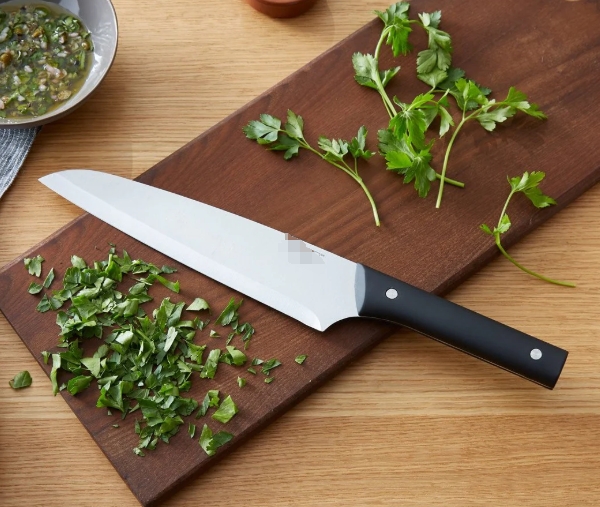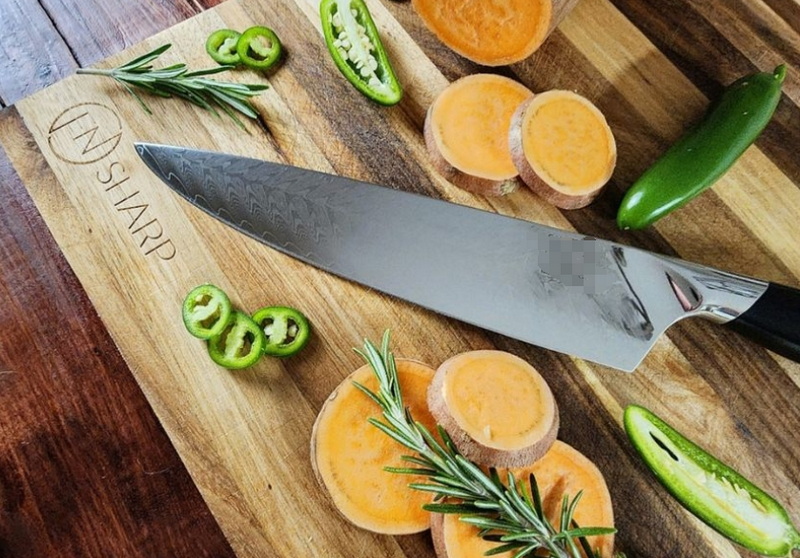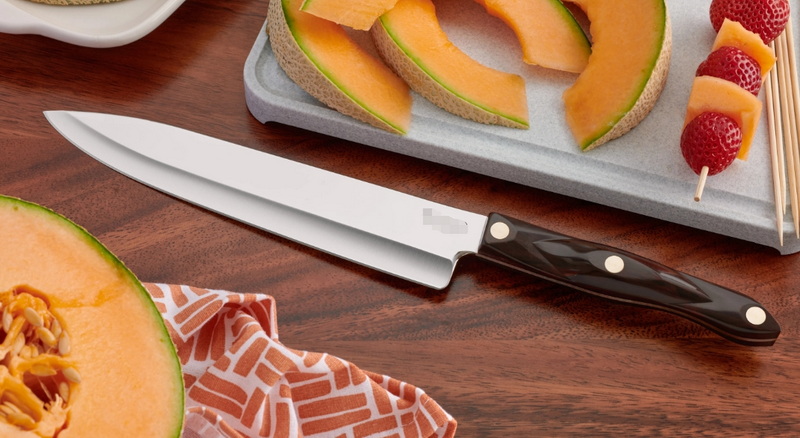

Views: 222 Author: Ella Publish Time: 2025-04-17 Origin: Site








Content Menu
● Understanding the Chef Knife and Cleaver
● Design and Construction Differences
● Functional Comparison: When to Use Each Knife
>> Limitations
● Types of Cleavers: Vegetable vs Meat Cleaver
● How to Use a Cleaver Effectively
● How to Use a Chef Knife Effectively
● Blade Materials and Maintenance
● Choosing the Right Knife for You
● Safety Tips for Using Chef Knives and Cleavers
● Frequently Asked Questions (FAQ)
>> 1. Should I Get a Cleaver or Chef Knife?
>> 2. What Is the Chinese Equivalent of a Chef's Knife?
>> 3. Can You Use a Chinese Cleaver for Everything?
>> 4. Why Do Chinese Cooks Use Cleavers?
>> 5. How Do I Maintain My Chef Knife and Cleaver?
When it comes to kitchen knives, two of the most iconic and versatile blades are the chef knife and the cleaver. Both have their unique designs, strengths, and ideal uses, but understanding their differences can elevate your cooking skills and efficiency. This comprehensive article explores the distinctions between a chef knife and a cleaver, their specific functions, and how to choose the right one for your culinary needs.

A chef knife, often called a cook's knife, is a staple in Western kitchens. It typically features a curved blade ranging from 6 to 12 inches long, tapering to a sharp pointed tip. This design allows for a rocking motion ideal for slicing, dicing, chopping, and mincing a wide variety of ingredients, from vegetables to meats.
- Blade Shape: Curved edge with a pointed tip
- Weight: Generally lighter and balanced between blade and handle
- Use: Precision cutting, fine slicing, trimming, and general-purpose tasks
The chef knife's versatility makes it the go-to knife for most home cooks and professional chefs. Its design supports a wide range of cutting techniques, including rocking, slicing, and chopping, making it suitable for almost any kitchen task.
The cleaver is recognized by its large, rectangular blade, often heavier and thicker than a chef knife. Originating from Chinese kitchens, the cleaver is a multifunctional tool capable of chopping, slicing, crushing, and even light bone cutting depending on the type.
- Blade Shape: Broad, rectangular blade with a flat edge
- Weight: Heavier and front-loaded, with most weight in the blade
- Use: Heavy chopping, crushing garlic, slicing vegetables, and some types can handle bones
The cleaver's broad blade surface also doubles as a tool for crushing garlic or ginger and for transferring chopped ingredients from the board to the pan, a feature not common in chef knives. Its weight provides the power needed to break down tougher ingredients efficiently.
The chef knife and cleaver differ significantly in design, which directly affects their function and handling.
- Blade Shape: The chef knife's curved blade allows for a smooth rocking motion, perfect for fine slicing and dicing. The cleaver's rectangular blade is designed for straight downward chopping and crushing.
- Blade Thickness: Chef knives have thinner blades to allow for precision and sharpness, while cleavers have thicker blades to withstand heavy chopping and impact.
- Weight: Chef knives are lighter and balanced for maneuverability, whereas cleavers are heavier with most of the weight concentrated in the blade to provide chopping power.
- Handle Design: Chef knife handles are ergonomically designed for comfort during prolonged use, while cleaver handles are sturdy and built to withstand heavy-duty chopping.
- Cutting Motion: Chef knives use a rocking motion, while cleavers rely on straight downward chops or push cuts.
The cleaver's broad blade also serves as a handy tool for crushing garlic cloves or ginger and scooping chopped ingredients, which adds to its multifunctionality in the kitchen.
- Precision Cutting: The pointed tip and curved blade allow for intricate work such as julienne, chiffonade, or trimming meat.
- Versatility: Ideal for slicing, dicing, mincing, and trimming a variety of foods.
- Handling Meat: Better suited for delicate tasks like cutting around bones or filleting due to its sharp tip and control.
- Everyday Use: Its balanced weight and ergonomic handle make it comfortable for extended use.
- Heavy-Duty Chopping: The cleaver's weight and thick blade make it perfect for chopping through dense vegetables and light bones (depending on the cleaver type).
- Multi-Functionality: Besides chopping, it can crush garlic and ginger, slice vegetables, and even scoop ingredients for transfer.
- Efficiency: The broad blade surface area helps in mincing and crushing tasks.
- Durability: Cleavers are built to withstand impact and heavy use without damaging the blade.
- Chef Knife: Not suitable for heavy chopping or cutting through bones; the blade can chip or dull quickly if misused.
- Cleaver: Less precise for fine slicing or delicate cuts; the weight can be cumbersome for extended use or intricate work.
It's important to distinguish between the Chinese vegetable cleaver (also called the Chinese chef's knife) and the meat cleaver:
- Vegetable Cleaver: Thinner, lighter, sharper edge designed for slicing vegetables and boneless meats. It's versatile and often mistaken for a chef knife due to its multipurpose use.
- Meat Cleaver: Heavier, thicker blade designed specifically for breaking down bones and tougher cuts of meat. It is not used for delicate slicing.
The vegetable cleaver is excellent for everyday kitchen tasks, offering a balance between slicing and chopping. The meat cleaver, on the other hand, is a specialized tool for butchery and heavy-duty preparation.

Mastering the cleaver involves specific techniques:
- Grip: Use either an all-purpose grip (handle close to blade) or a pinch grip (thumb and index finger on blade) for control and safety.
- Chopping Motion: Employ a straight downward chop or a push cut for vegetables and meat.
- Precision Slicing: Maintain a slight tilt to achieve thin, even slices.
- Scooping: Use the broad blade to transfer chopped ingredients efficiently without using the sharp edge.
Using a cleaver properly requires practice to ensure safety and efficiency. The weight of the cleaver can be intimidating, but with proper technique, it becomes a highly effective tool.
The chef knife's design supports multiple cutting techniques:
- Rocking Motion: The curved blade allows the tip to stay on the cutting board while the heel moves up and down, perfect for mincing herbs or dicing onions.
- Slicing: Use a smooth forward and backward motion to slice through vegetables or meat cleanly.
- Chopping: For harder vegetables, use a straight chopping motion with the heel of the blade.
- Precision Work: The pointed tip is perfect for trimming fat or peeling fruits.
Maintaining a relaxed grip and using the correct cutting technique will reduce fatigue and improve your cutting accuracy.
Both chef knives and cleavers come in various materials, each affecting performance and maintenance:
- Stainless Steel: Resistant to rust and easy to maintain, but may require frequent sharpening.
- Carbon Steel: Holds a sharper edge longer but is prone to rust and requires careful drying and oiling.
- High Carbon Stainless Steel: Combines sharpness and rust resistance, popular in high-quality knives.
- Damascus Steel: Known for its beautiful layered pattern and excellent edge retention, often found in premium knives.
Proper maintenance is crucial for both knives:
- Sharpening: Chef knives require regular sharpening to maintain their thin, sharp edges. Cleavers, due to their thicker blades, need less frequent sharpening but should still be maintained.
- Honing: Use a honing rod regularly to keep the edge aligned.
- Cleaning: Hand wash and dry immediately to prevent corrosion.
- Storage: Store in a knife block, magnetic strip, or blade guard to protect the edge.
Consider these factors when deciding between a chef knife and a cleaver:
- Type of Cooking: For Western-style cooking involving fine slicing and precision, a chef knife is preferable. For Asian cuisines or heavy-duty chopping, a cleaver is more suitable.
- Tasks: Use a chef knife for delicate tasks like trimming meat and julienne cuts. Use a cleaver for crushing, chopping tougher vegetables, and some bone work (meat cleaver only).
- Comfort and Handling: Chef knives are lighter and easier for prolonged use; cleavers require more strength but offer power for tough jobs.
- Blade Maintenance: Chef knives often require more frequent sharpening due to thinner blades, while cleavers are more durable but still need proper care.
- Budget: High-quality chef knives and cleavers vary widely in price. Investing in a good-quality knife can improve your cooking experience and longevity.
Many professional kitchens keep both knives on hand, using each for its strengths. For home cooks, starting with a good chef knife is often recommended, adding a cleaver if your cooking style demands it.
Using any sharp kitchen tool requires attention to safety:
- Keep Blades Sharp: Dull blades require more force and increase the risk of slipping.
- Use a Stable Cutting Board: A non-slip board prevents accidents.
- Proper Grip: Hold the knife securely with your dominant hand and curl your fingers on the other hand to guide cuts safely.
- Cut Away From Your Body: Always direct the blade away from yourself.
- Store Safely: Keep knives out of reach of children and store blades properly.
Following these tips ensures a safer and more enjoyable cooking experience.
Both the chef knife and cleaver are invaluable tools in the kitchen, each excelling in different areas. The chef knife offers precision, versatility, and control, making it ideal for everyday slicing, dicing, and trimming. The cleaver, with its robust and broad blade, is perfect for heavy-duty chopping, crushing, and multitasking in food prep. Your choice depends on your cooking style, the types of ingredients you handle, and personal comfort.
For a well-rounded kitchen, many chefs and home cooks keep both knives handy, using each for its strengths. Whether you prefer the nimble precision of a chef knife or the powerful versatility of a cleaver, mastering both will elevate your culinary skills.

Choose a chef knife for versatile, everyday kitchen tasks like slicing, dicing, and mincing. Opt for a cleaver if you often chop through tough vegetables or bones, or need a multipurpose tool for crushing and transferring ingredients.
The Chinese equivalent is the Chinese cleaver, sometimes called the "Cai Dao." It serves as a multipurpose knife for slicing, chopping, mincing, and light bone work.
A Chinese cleaver is versatile for fruits, vegetables, herbs, and boneless meats but is not suitable for cutting through bones unless it is a heavy-duty meat cleaver designed specifically for that purpose.
Chinese cooks use cleavers because they combine multiple functions in one tool—slicing, chopping, crushing, and scooping—making food preparation efficient and streamlined in Chinese cooking techniques.
Keep both knives sharp by regular honing and occasional professional sharpening. Store them properly to avoid damage, and clean them immediately after use. Cleavers, especially carbon steel ones, require careful drying to prevent rust.
[1] https://www.reddit.com/r/Cooking/comments/tkhgbm/chinese_cleaver_vs_chefs_knife/
[2] https://www.istockphoto.com/photos/chef-knife
[3] https://www.istockphoto.com/photos/cleaver
[4] https://www.youtube.com/watch?v=YrHpeEwk_-U
[5] https://www.youtube.com/watch?v=v5ZWpwk4HSg
[6] https://ubaahaus.co.uk/blogs/blog-archive/do-i-need-a-chinese-chef-knife
[7] https://yakushiknives.com/blogs/yakushi-blog-all-thing-knives/how-to-use-a-cleaver-knife
[8] https://www.escoffier.edu/blog/culinary-arts/different-knives-and-the-best-uses-for-each/
[9] https://dexter1818.com/uncategorized/the-battle-of-blades-cleaver-vs-chinese-chefs-knfe/
[10] https://www.istockphoto.com/illustrations/chef-knife
[11] https://www.koiknives.com/blogs/japanese-knives/meat-cleaver-faqs
[12] https://cookingpanda.com/blogs/food-news/chinese-cleaver-vs-chef-knife
[13] https://www.wusthof.com/collections/all-purpose-knives/chefs-knives
[14] https://tradingpieces.co.nz/chinese-cleaver-or-chef-knife/
[15] https://www.seriouseats.com/chinese-cleaver-kitchen-knife
[16] https://www.nytimes.com/wirecutter/blog/why-i-use-a-chinese-cleaver/
[17] https://www.youtube.com/watch?v=HdlmaKelgfY
[18] https://www.youtube.com/watch?v=o_QWK4AC7R0
[19] https://cutleryandmore.com/collections/chinese-chefs-knives
[20] https://eatingtools.com/collections/chef-knives
[21] https://stock.adobe.com/search?k=%22chef+knives%22
[22] https://www.youtube.com/watch?v=QgVyN6Lpiuc
[23] https://www.youtube.com/watch?v=-EZBi9O_0rw
[24] https://unsplash.com/s/photos/chef-knife
[25] https://unsplash.com/s/photos/cleaver
[26] https://www.reddit.com/r/cookingforbeginners/comments/1fb6b8w/knife_skills_video/
[27] https://www.youtube.com/watch?v=ALMGj0Q3p0I
[28] https://stock.adobe.com/search/images?k=%22french+knife%22
[29] https://www.shutterstock.com/search/ancient-cleavers
[30] https://www.youtube.com/watch?v=-al-bs737fw
[31] https://www.youtube.com/watch?v=_GPyO8Wquz4
[32] https://www.reddit.com/r/Cooking/comments/tkhgbm/chinese_cleaver_vs_chefs_knife/
[33] /kitchen-knife-vs-cleaver-which-is-better-for-meat.html
[34] https://www.seriouseats.com/chinese-cleaver-kitchen-knife
[35] https://www.chefknivestogoforums.com/viewtopic.php?t=6382
[36] https://www.kitchenknifeforums.com/threads/question-about-the-chinese-cleaver.75364/
[37] https://cooking.stackexchange.com/questions/6158/what-should-i-look-for-in-a-good-multi-purpose-chefs-knife
[38] https://www.thebambooguy.com/blogs/kitchen-knives/what-is-a-meat-cleaver-and-how-do-you-use-it
[39] https://www.chefknivestogoforums.com/viewtopic.php?t=3987
[40] https://elementknife.com/pages/common-questions-about-kitchen-knives
[41] https://www.mercerculinary.com/preview/faqs/
[42] https://www.reddit.com/r/Cooking/comments/ipqtc/knife_skills_and_cleaver_questions/
[43] https://www.vecteezy.com/free-vector/chef-knife
[44] https://www.istockphoto.com/illustrations/meat-cleaver
[45] https://www.chefknivestogoforum.com/looking-for-a-chef-knife-and-a-cleaver-t316.html